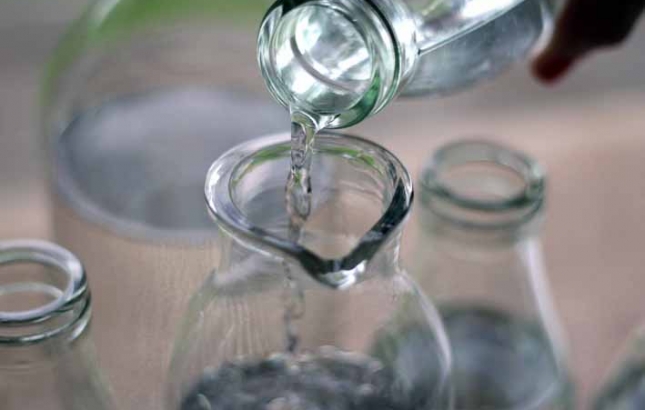
Tapping into Water
"Drink more water” is set in stone as one of the most fundamental guidelines in the pool of health advice splashed around our everyday lives. Water makes up about 60% of our body weight and is more important to life than any other nutrient. We can survive without food for about five weeks (I use the word ‘survive’ over ‘live’ as you’d certainly be pretty miserable…), but without adequate water, we would poison ourselves with our own metabolic wastes and our life would end in just three days. So, why exactly is water so good for us, and more importantly, what is the best water for us…
"Drink more water” is set in stone as one of the most fundamental guidelines in the pool of health advice splashed around our everyday lives. Water makes up about 60% of our body weight and is more important to life than any other nutrient. We can survive without food for about five weeks (I use the word ‘survive’ over ‘live’ as you’d certainly be pretty miserable…), but without adequate water, we would poison ourselves with our own metabolic wastes and our life would end in just three days. So, why exactly is water so good for us, and more importantly, what is the best water for us…
Recent posts by Renée Leonard-Stainton
In the body, water becomes the fluid in which all life processes occur including digestion, absorption, circulation, and excretion. Some of the functions of water in the body include the following;
- Carries nutrients and waste products throughout the body
- Participates in metabolic reactions
- Acts as a lubricant and cushion around joints and inside the eyes, the spinal cord, and, in pregnancy, the amniotic sac surrounding the fetus and womb.
- Aids in the regulation of normal body temperature; evaporation of sweat from the skin removes excess heat from the body.
- Maintains blood volume
In everyday terms, what does this translate to? Plump, clear and glowing skin, sparkling eyes, cellulite reduction, regular bowel motions and a healthy you! I’ll ‘drink to that’ thank you very much (on this note…it reminds me to mention…alcohol doesn’t count as fluid intake sorry!)
When too much water is lost from the body, and not enough is replaced, dehydration develops. A first sign of dehydration is thirst, the signal that the body has already lost some of its fluid. Thirst drives a person to seek water, but it lags behind the body’s need.To maintain water balance, intake from liquids, foods and metabolism must equal losses from the kidneys, skin, lungs, and digestive tract. A general guideline is 8 glasses per day, but you should always increase this if you are exercising or perspiring a lot, to keep your body’s water level in balance. The obvious dietary source of water is, well, water and other beverages, but nearly all foods also contain water (most fruits and vegetables contain up to 90% water!)
There are loads of different types of water available in the market, and it can be confusing to understand which is the best for us. There is currently a great concern over our water supply as it’s becoming increasingly difficult to find pure water. Lots of our water supply is full of chemicals, including not only chlorine and fluoride, which are routinely added, but a wide range of toxic organic compounds and chemicals such as PCBs, pesticide residues, nitrates, and heavy metals such as lead, mercury, and cadmium. There are different types of water, some better than others and likewise, there are differing filtering methods, some better than others…
Tap water: Water that comes out of a household tap is generally obtained from either surface water (water that has run off from ponds, creeks, streams, rivers, and lakes and is collected in reservoirs) or from ground water (water that has filtered through the ground and is extracted by means of a well). Most people assume that when they turn on the kitchen tap, they’re getting clean, safe, healthy drinking water. Unfortunately, this is often not the case. Regardless of the original source of tap water, it is vulnerable to a number of different types of impurities, and may be full of harmful chemicals and inorganic minerals that the body cannot use. Some undesirable substances found in water, including fluoride, and arsenic as well as iron, lead and copper, and other heavy metals, can occur naturally. Other contaminants such as fertilizers, herbicides, pesticides, and industrial chemicals may leach into ground water through the soil, or into any tap water from plumbing pipes. Many of these chemicals have been linked to cancer and other disorders. Water can also contain biological contaminants including chlorine, carbon, phosphates, aluminum, which are intentionally added to public water supplies to kill bacteria, adjust pH, and eliminate cloudiness, among other things.
Artesian water: Water drawn from a well that taps a confined aquifer in which the water is under pressure.
Bottled water: Drinking water sold in bottles. This can be mineral, purified or other, and will be labeled as such.
Carbonated water: Water that contains carbon dioxide gas, either naturally occurring or added, that causes bubble to form in it.; also called bubbling or sparkling water.
Distilled water: Water that has been vaporized and recondensed, leaving it free of dissolved minerals
Filtered water: Water treated by filtration, usually throughactivated carbon filters that reduce the lead in tap water, or byreverse osmosis units that force pressurized water across a membrane removing lead, arsenic, and some microorganisms from tap water
Hard water: Water with a high calcium and magnesium content.
Mineral water: Water from a well that typically contains 250 to 500 parts per million of minerals. Minerals give a distinctive flavour. Some mineral waters are high in sodium.
Natural water: Water obtained from a spring or well that is certified to be safe and sanitary. The mineral content may not be changed, but the water may be treated in other ways such as with ozone or by filtration.
Purified water: Water that has been treated by distillation or other physical or chemical processes that remove dissolved solids. Because purified water contains no minerals or contaminants, it is useful for medical purposes.
Soft water: Water with a high sodium or potassium content.
Spring water: Water originating from an underground spring or well.
Well water: Water drawn from ground water by tapping into an aquifer.
Nature filters water as the water runs through streams and it seeps down through the soil and rocks to the water table. As water passes through the earth or over rocks in a stream, the bacteria in the water leech into the rocks and are replaced with minerals such as calcium and magnesium. Fortunately, there are also man- made ways of filtering water as we’re not all lucky enough to be living near a beautiful stream delivering us the pure necessity of life day in, day out!
It’s important to note that not all drinking water contains significant amounts of toxic substances and not all cities and towns process their water in the same way, so you can check with your local council, or if you are getting a home water purifier, check with your installer, as they can let you know what filter is best for the contaminants specific to your area. At the end of the day, any water deemed clean enough to drink is certainly better than no water.
Live well, live long, live naturally
Renee x



